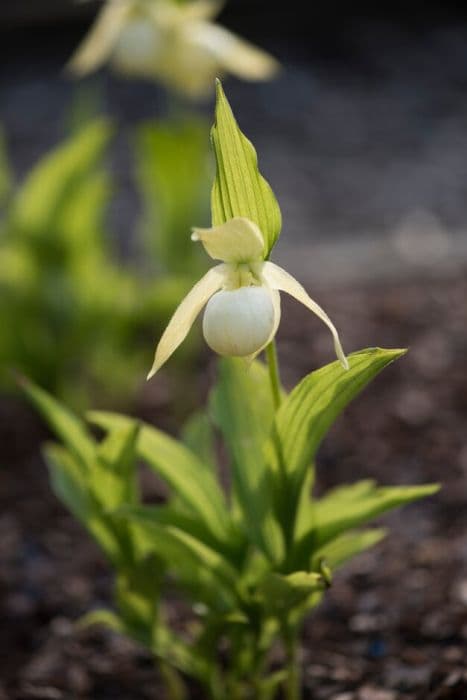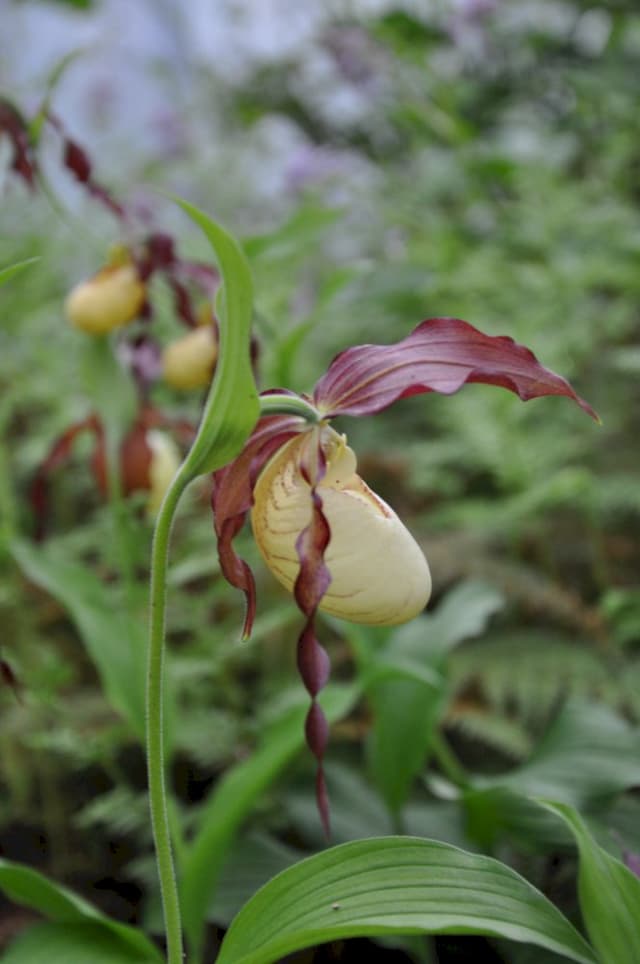Lady's Slipper Orchid Cypripedium Victoria gx

ABOUT
The Cypripedium Victoria, more commonly known as the Lady's Slipper Orchid, is a striking plant with a distinctive appearance. This plant boasts a beautiful and complex flower that is the main attraction. The flower has a pouch-shaped petal that is often compared to a slipper, giving the plant its common name. This pouch is typically a rich, deep color, often shades of purple, pink, or white, and can be spotted or plain. Surrounding the central pouch are other petals and sepals that can be long and twisted or wavy, with colors that elegantly contrast or complement the main slipper petal. These can range from white and soft pastels to bold magenta or green. The foliage of the Lady's Slipper Orchid forms a clumping base from which the flower stalks emerge. The leaves are typically broad and can have a pleated or ribbed texture, displaying a lush green color that serves as a beautiful backdrop to the dramatic flowers. Some varieties may have mottled or speckled leaves that add to the visual interest of the plant even when not in bloom. The overall structure of the plant is robust, with strong stalks that support the blooms and a root system that anchors it firmly in its growing medium.
About this plant
 Names
NamesFamily
Orchidaceae.
Synonyms
Queen's Lady's Slipper, Royal Lady's Slipper, Queen Victoria's Slipper Orchid.
Common names
Cypripedium Victoria gx.
 Toxicity
ToxicityTo humans
The Cypripedium Victoria gx, commonly known as Lady's Slipper Orchid, does not have a well-documented profile of toxicity to humans. Most orchids, including the Lady's Slipper variety, are generally considered non-toxic to humans. They do not usually contain compounds known to cause severe poisoning when touched or ingested. However, individuals might experience mild symptoms like skin irritation or allergic reactions if they are sensitive to the Lady's Slipper Orchid or other orchids. Ingestion is not common and typically does not lead to severe consequences, but as with any non-food plant, it is not advisable to eat any part of it due to the risk of stomach upset or potential unknown toxins.
To pets
The Lady's Slipper Orchid, like its human toxicity profile, is not recognized as being poisonous to pets. While it is not typical for pets to ingest this plant, should a pet consume it, they are unlikely to suffer from serious poisoning. Symptoms could include mild gastrointestinal upset, such as vomiting or diarrhea, if the plant were to be ingested in large quantities. It is generally advisable to prevent pets from consuming non-food plants as a precautionary measure. If a pet does consume Lady's Slipper Orchid and exhibits symptoms, it is best to consult a veterinarian.
 Characteristics
CharacteristicsLife cycle
Perennials
Foliage type
Deciduous
Color of leaves
Green
Flower color
Mixed
Height
1-2 feet (0.3-0.6 meters)
Spread
1 foot (0.3 meters)
Plant type
Herb
Hardiness zones
5
Native area
Asia
Benefits
 General Benefits
General Benefits- Aesthetic Appeal: The striking flowers of the Lady's Slipper Orchid, which Cypripedium Victoria is a part of, provide an elegant and unique ornamental touch to gardens and homes.
- Habitat Support: These orchids can support local ecosystems by providing habitat and food resources for pollinators such as bees and butterflies.
- Biodiversity: Adding native orchids like the Lady's Slipper to a garden can help maintain and increase plant diversity, which is vital for a healthy ecosystem.
- Educational Value: Cultivating plants like the Lady's Slipper Orchid can be an opportunity for individuals to learn more about botany, conservation, and the specific needs of different plant species.
- Conservation: By growing and maintaining species such as Cypripedium Victoria, gardeners can partake in the conservation efforts of native orchids and their habitats.
 Medical Properties
Medical PropertiesThis plant is not used for medical purposes.
 Air-purifying Qualities
Air-purifying QualitiesThis plant is not specifically known for air purifying qualities.
 Other Uses
Other Uses- Lady's slipper orchids, such as the Cypripedium Victoria gx, can be used as a unique natural pest deterrent when planted in gardens due to their complex structures that attract and occasionally trap insects.
- These orchids could serve as a study subject for botanists and horticulturalists interested in plant pollination mechanisms due to their deceptive pollination strategy, attracting pollinators without offering a reward.
- Lady's slipper orchids are sometimes incorporated into art and photography projects for their striking appearance, serving as a muse to many artists and photographers.
- They can be used in ceremonial contexts or special occasions, such as weddings or anniversaries, due to their unique beauty and rarity.
- These plants are sometimes used in educational settings, like schools or botanical gardens, to teach about endangered species and the importance of conservation efforts.
- In landscaping, the appealing aesthetics of lady's slipper orchids make them an ideal candidate for creating focal points in shade gardens.
- Cultural symbolism: In some cultures, orchids like the lady's slipper are associated with luxury and sophistication, making them suitable gifts to convey a sense of refinement and thoughtfulness.
- Eco-tourism attraction: Areas where these orchids are naturally found can become attractions for eco-tourists interested in rare plant species and biodiversity.
- Scientific research: The complex hybridization of orchids such as Cypripedium Victoria gx, can provide material for genetic studies and research into hybrid vigor and plant adaptation.
- Theme gardens: The orchids can be used to create theme gardens that showcase plant varieties from specific geographical regions or those that have unique evolutionary adaptations.
Interesting Facts
 Feng Shui
Feng ShuiThe Lady Slipper Orchid is not used in Feng Shui practice.
 Zodiac Sign Compitability
Zodiac Sign CompitabilityThe Lady Slipper Orchid is not used in astrology practice.
 Plant Symbolism
Plant Symbolism- Refinement and Beauty: The Cypripedium, commonly known as the Lady's Slipper Orchid, often symbolizes refined beauty due to its elegant and unique appearance.
- Rarity and Value: Since many species of Lady's Slipper Orchids are rare and consequently protected, they are seen as a symbol of value and preciousness.
- Capriciousness: The Lady's Slipper Orchid can be difficult to grow and requires specific conditions to thrive, which can represent capricious or whimsical behaviour in humans.
- Femininity and Fertility: The shape of the orchid's pouch resembles a slipper or a cradle, which is often associated with feminine energy and fertility.
 Water
WaterThe Lady's Slipper Orchid, most commonly known as the Lady's Slipper, should be watered cautiously to keep the medium slightly moist, never allowing it to completely dry out. During active growth in spring and summer, watering once every 5 to 7 days with lukewarm water is ideal, using about one to two gallons per month for a medium-sized plant. In fall and winter, when the plant is not actively growing, reduce the watering frequency to once every 10 to 14 days. Over-watering can lead to root rot, so it's essential to ensure proper drainage.
 Light
LightLady's Slipper Orchids thrive in bright, indirect light but must be protected from direct sunlight, which can scorch their leaves. A north or east-facing window is perfect for providing the gentle light they prefer. If natural light is insufficient, grow lights can be used for 10-12 hours per day to supplement.
 Temperature
TemperatureLady's Slipper Orchids prefer moderate temperatures with a range between a maximum of 75°F and a minimum of 50°F, making them well-suited to typical indoor conditions. The ideal temperature range for these orchids is between 60°F and 70°F. Protecting them from sudden temperature changes and drafts is crucial to their health.
 Pruning
PruningPruning of the Lady's Slipper Orchid is typically done to remove spent blooms and dead or damaged leaves. This can be done as needed throughout the year, but the best time is usually right after flowering, which encourages healthy new growth. Pruning helps to promote good air circulation and prevents disease, enhancing the plant's overall health and appearance.
 Cleaning
CleaningAs needed
 Soil
SoilLady Slipper Orchid (Cypripedium Victoria gx) benefits from a soil mix composed of bark, perlite, and loam, ensuring good drainage and aeration. It prefers slightly acidic to neutral pH, ranging from 6.0 to 7.0.
 Repotting
RepottingLady Slipper Orchids should be repotted every 2 to 3 years to refresh the soil and accommodate their growing roots, ideally in the spring after flowering.
 Humidity & Misting
Humidity & MistingLady Slipper Orchids thrive in moderate to high humidity levels, between 40% to 70%, which is essential for their growth and flowering process.
 Suitable locations
Suitable locationsIndoor
Provide bright, indirect light and maintain high humidity.
Outdoor
Shelter from direct sun; mulch well; protect from extreme cold.
Hardiness zone
4-8 USDA
 Life cycle
Life cycleThe Lady Slipper Orchid (Cypripedium Victoria gx) starts its life cycle when its seeds, which lack endosperm, germinate in symbiosis with a mycorrhizal fungus. Seedlings develop a protocorm, which is a tuber-like structure that helps absorb nutrients provided by the fungus. As the orchid grows, it develops true roots and leaves to begin photosynthesis, although it may rely on fungal associations for years before becoming fully autotrophic. This orchid typically matures slowly, taking several years to reach flowering size. Once mature, the Lady Slipper Orchid will produce distinctive flowers yearly, often in late spring or early summer, attracting pollinators with their unique shape and coloration. After pollination, the plant will set seed in a capsule, which, when mature, releases thousands of tiny seeds to the wind, thereby completing its lifecycle and starting the process anew.
 Propogation
PropogationPropogation time
Spring-Early Summer
The Lady Slipper Orchid (Cypripedium Victoria gx) is typically propagated by division, which is the most popular method due to its reliability and simplicity. Division should be carried out in the late summer or early fall, just after the plant has finished flowering and has begun to go dormant. To propagate by division, carefully unearth the plant and gently separate the rhizomes, ensuring that each division has at least one growth bud. These divisions can then be planted in a well-draining soil mix, placed at the same depth they were previously growing. Adequate moisture should be maintained without overwatering to encourage the establishment of the new divisions.









